
Soho is an area of the City of Westminster, part of the West End of London. Originally a fashionable district for the aristocracy, it has been one of the main entertainment districts in the capital since the 19th century.

Robert Adam was a British neoclassical architect, interior designer and furniture designer. He was the son of William Adam (1689–1748), Scotland's foremost architect of the time, and trained under him. With his older brother John, Robert took on the family business, which included lucrative work for the Board of Ordnance, after William's death.

Thomas Chippendale (1718–1779) was a cabinet-maker in London, designing furniture in the mid-Georgian, English Rococo, and Neoclassical styles. In 1754 he published a book of his designs in a trade catalogue titled The Gentleman and Cabinet Maker's Director—the most important collection of furniture designs published in England to that point which created a mass market for furniture—upon which success he became renowned. According to the Victoria and Albert Museum, "so influential were his designs, in Britain and throughout Europe and America, that 'Chippendale' became a shorthand description for any furniture similar to his Director designs".

Soho Square is a garden square in Soho, London, hosting since 1954 a de facto public park let by the Soho Square Garden Committee to Westminster City Council. It was originally called King Square after Charles II, and a much weathered statue of the monarch has stood in the square, with an extended interruption, since 1661, one year after the restoration of the monarchy.
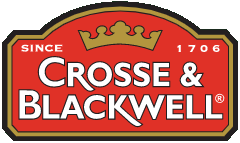
Crosse & Blackwell is a British food brand. The original company was established in London in 1706, then was acquired by Edmund Crosse and Thomas Blackwell in 1830. It became independent until it was acquired by Swiss conglomerate Nestlé in 1960.
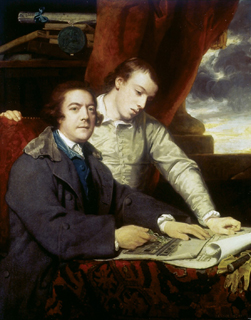
James Paine (1717–1789) was an English architect.

Nostell Priory is a Palladian house in Nostell, West Yorkshire, England, near Crofton on the road to Doncaster from Wakefield. It dates from 1733, and was built for the Winn family on the site of a medieval priory. The Priory and its contents were given to the National Trust in 1953 by the trustees of the estate and Rowland Winn, 3rd Baron St Oswald.
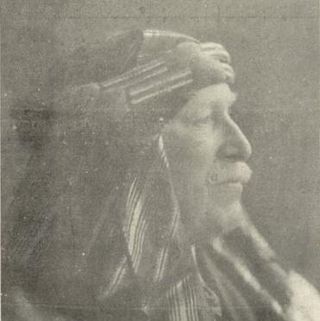
Lord Headley, Baron Allanson and Winn, of Aghadoe in the County of Kerry, was a title in the Peerage of Ireland. It was created in 1797 for Sir George Allanson-Winn, 1st Baronet, a former Baron of the Court of the Exchequer and Member of Parliament for Ripon. He had already been created a Baronet, of Little Warley in the County of Essex, in the Baronetage of Great Britain on 14 September 1776. His son, Charles Winn-Allanson, 2nd Baron Headley, represented Ripon, Malton and Ludgershall in Parliament. In 1833 he succeeded a distant relative as 8th Baronet, of Nostel. His nephew, the third Baron, sat in the House of Lords as an Irish Representative Peer from 1868 to 1877. His son, the fourth Baron, was an Irish Representative Peer from 1883 to 1913. His cousin, Rowland Allanson-Winn, 5th Baron Headley, was a prominent convert to Islam. On the death in 1994 of the latter's younger son, Charles Allanson-Winn, 7th Baron Headley, the titles became extinct.

Grim's Dyke is a house and estate in Harrow Weald, in northwest London, England. The house was built from 1870 to 1872 by Richard Norman Shaw for painter Frederick Goodall and named after the nearby prehistoric earthwork known as Grim's Ditch. It was converted into a hotel, Grim's Dyke Hotel, in 1970.

Rowland Winn, 1st Baron St Oswald was an English industrialist and Conservative Party politician.

The Priory Church of St Mary and St Hardulph is the Church of England parish church of Breedon on the Hill, Leicestershire, England. The church has also been known as Breedon Priory and as the Holy Hill Monastery.

Robert Lewis Roumieu otherwise R.L. Roumieu, was a 19th-century English architect whose designs include Milner Square in Islington and an idiosyncratic vinegar warehouse at 33–35 Eastcheap in the City of London. A pupil of Benjamin Dean Wyatt, he worked in partnership with Alexander Dick Gough between 1836 and 1848.
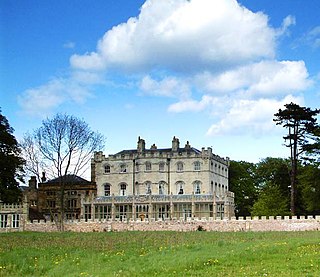
The Castle at Castle Eden, County Durham, England, is an 18th-century, Palladian style, mansion house and a Grade II* listed building. No trace remains of the medieval castle of Robert the Bruce.
George Allanson-Winn, 1st Baron Headley, known as Sir George Allanson-Winn, Bt, between 1776 and 1797, was a British barrister, judge and politician.

Hirst Priory is an 18th-century country house and grounds in Belton on the Isle of Axholme, North Lincolnshire, United Kingdom. The current building was built upon the site of a 12th-century Augustinian priory.
Fauconberg House was a house in Soho Square in the City of Westminster, London. It was demolished in 1924.
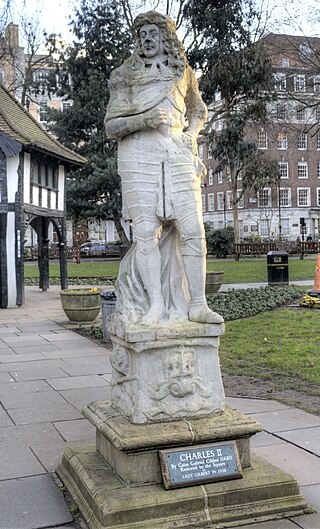
The statue of Charles II is an outdoor sculpture of Charles II of England by the Danish sculptor Caius Gabriel Cibber, located near the centre of Soho Square in London. Once part of a late 17th century fountain, it was removed in the late 19th century to a private estate in Harrow before being restored to the square in the mid-20th century. It depicts the king in a standing pose on top of a low decorated pedestal. Although it has been the subject of restoration works, it is heavily eroded and in a poor condition.

Sir Thomas More and Family is a lost painting by Hans Holbein the Younger, painted circa 1527 and known from a number of surviving copies.

Hitchin Priory in Hitchin in Hertfordshire is today a hotel built in about 1700 on the site of a Carmelite friary founded in 1317, which was closed in the Dissolution of the Monasteries during the reign of Henry VIII. Parts of the original priory are incorporated in the existing building, which has been a Grade I listed building on the Register of Historic England since 1951.
John Deval (1701–1774) was an 18th-century British sculptor and Master Mason, as was his namesake son (1728–1794). He was Chief Mason to the Crown and was the mason for the Tower of London and Royal Mews.

















